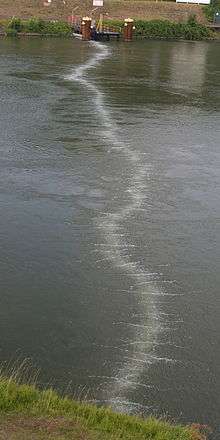Pneumatic barrier

A pneumatic barrier is a method of containing oil spills. Air bubbling through a perforated pipe causes an upward water flow that slows the spread of oil. It can also be used to stop fish from entering polluted water. Pneumatic barriers are also known as air curtains.
A pneumatic barrier is an active (as opposed to passive) method of waterway oil spill control. (An example of a passive method would be a containment boom.)
Method of operation
The pneumatic barrier consists of perforated pipe and a compressed air source. Air escaping from the pipe provides a "hump" of rising water and air which contains the oil spill. Anchors keeping the pipe in a decided spot are helpful.
Unique considerations
At water current speeds exceeding one foot per second, the pneumatic barrier no longer functions effectively, limiting deployable sites.
Environmental issues
The release of compressed air in the water adds oxygen to the local environment. This may be particularly useful in an area which has become a dead zone due to eutrophication.
Air curtains may have another application. Dolphin and whale beaching has increased with the rise in ocean temperatures. On Thursday, February 12, 2017, a group of nearly 400 whales began to beach near Golden Bay on the tip of New Zealand’s South Island, following a similar incident earlier that week. The simplicity of an air curtain system, requiring only air compressors and perforated hoses, would allow for rapid deployment and create aerated zones of oxygenated seawater during a marine emergency.
Air curtains are also used to control the release of smoke particulates into the environment. After a natural disaster, or during brush clearing activities, debris is disposed of by incineration in either a ceramic or earth pit containment. Just as an air curtain serves to separate indoor air from outdoor air as, for instance, in restaurants and walk-in refrigerators, a powerful air curtain can defeat the chimney effect of the incineration process to eliminate any smoke from a brush incinerator. The air curtain acts as a lid on the process, and forces the smoke back into the fuel bed for a cleaner burn.
Disadvantages
Like all active systems of any type, a mechanical failure can result in total failure of protection.
External links
Development of an air bubble curtain to reduce underwater noise of percussive piling Marine Environmental Research 49(2000)79-93, Elsevier Retrieved 2/16/2017
Bubble Curtains: Can They Dampen Offshore Energy Sound for Whales? National Geographic Retrieved 2/16/2017
You Tube: How an Air Curtain Works by Berner International Retrieved 2/16/2017